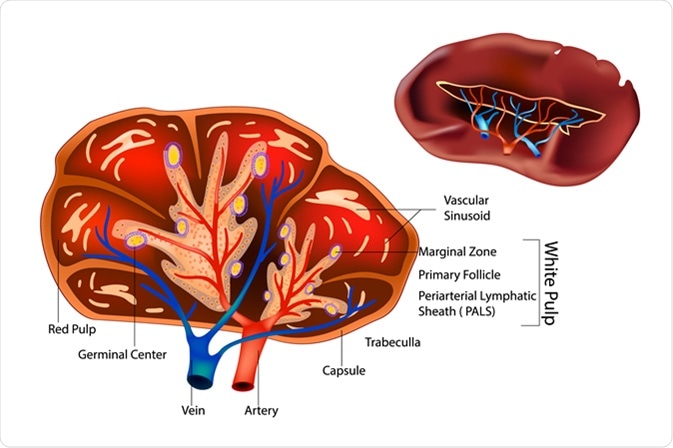The spleen is a soft, spongy organ located in the upper left part of the abdomen, just beneath the diaphragm. It is the largest lymphoid organ and is equipped with an intriguing microanatomy.
The spleen is surrounded by a connective tissue capsule made up of collagen, reticular fibers, and smooth muscle cells. From the capsule, strands of connective tissue, termed trabeculae, extend into the pulp region of the spleen. Splenic pulp, also called the splenic parenchyma, is divided into two functionally distinct regions: red pulp and white pulp.

Structure of the Spleen. Image Credit: Sakurra / Shutterstock
Red pulp comprised of:
- Sinusoids and splenic cords – Consists of reticular cells and fibers, which are filled with blood
- Marginal zone – A border between the white pulp and red pulp; consists of numerous macrophages
White pulp comprised of:
- Nodules - called Malpighian corpuscles, which contains lymphoid follicles
- B-lymphocytes and T-lymphocytes
The elaborate tissue structure of the spleen links the organ to the liver by means of the portal vein system.

Liver, pancreas, gallbladder and spleen. Image Credit: Tefi / Shutterstock
What is the Physiologic Role of the Spleen?
- Monitoring of the immune system
- Filtration of aged and diseased red blood cells
- Creation of blood cells from hematopoietic stem cells
- Regulation of blood volume
Spleen in Drug Metabolism
As evident from its structural characteristics, the spleen is highly permeable to blood-borne molecules. The splenic parenchyma acts as a distribution platform for numerous drugs that are excluded from other major sites of drug metabolism either due to their large size or their charge. The microanatomy of the spleen makes new generation drugs such as monoclonal antibodies, nanoparticles, and liposomes accessible to the splenic parenchyma.
The amount of drug that enters the parenchyma depends on splenic blood flow. The spleen has a very high blood flow, which makes it one of the most highly perfused organs; However, due to its small weight, the spleen receives only 4.8 ± 1.5% of the total cardiac output. This, in turn, reduces the overall impact of the spleen in the management of drug distribution inside the body.
After the blood enters the spleen, it can perfuse through the white pulp via the marginal zone or break into the red pulp and reach the splenic cords.
Processing of Classical Drugs
Blood-borne drugs are usually directed to the white pulp region of the spleen where they are exposed to lymphocytes and macrophages, the major cells present in the white pulp. Interactions between drugs and these cells have been associated with therapeutic activity, toxicity and elimination.
Macrophages are targets for drugs such as fluoroquinolones and clofazimine, whereas drugs cyclosporine and saquinavir-ritonavir work in conjunction with lymphocytes.
Drugs transporters, such as concentrative nucleoside transporter and monocarboxylate transporter, play a key role in intracellular transport of drugs that target macrophages. Various drug-metabolizing enzymes, such as those belonging to the cytochrome P450 family, are also expressed by macrophages and lymphocytes.
Disposition of New Generation Drugs
New generation drugs such as monoclonal antibodies, nanoparticles, and liposomes are disposed of by different mechanisms such as
- Internalization of opsonized small particles
- Capture by marginal zone macrophages
- Internalization by red pulp macrophages
Monoclonal antibodies have a high molecular weight and are highly polar molecules. They penetrate the splenic parenchyma by way of convection.
Splenic macrophages and internalization of opsonized particles are the mechanisms responsible for the uptake of nanoparticle.
Another interesting mechanism for nanoparticle disposition includes the formation of a protein corona which is recognized by scavenger receptors, and ultimately clearance via the reticuloendothelial system.
Nanoparticles with particles larger than 100–200 nm are unable to cross the endothelial slit of splenic sinuses. These are thus filtered and retained in the red pulp of the spleen. With time, the macrophages present in the red pulp internalize the particles and destroy them.
The spleen is often referred to as the neglected organ. However, its emerging role in the metabolism of numerous drugs, particularly the new generation drugs, warrants more research to better understand its role in pharmacokinetics.
Further Reading